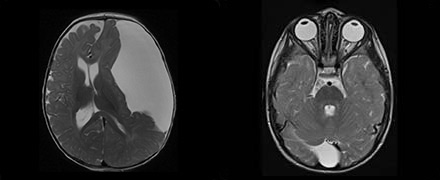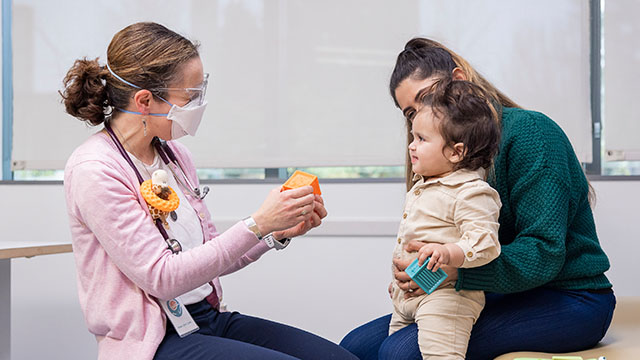Arachnoid Cyst
What is an arachnoid cyst?
An arachnoid (ah-RACK-noid) cyst is a sac filled with fluid inside the head or spine. Arachnoid cysts develop between the brain or spinal cord and the membrane that covers the brain and spinal cord, called the arachnoid membrane. The fluid in the cyst is cerebrospinal fluid (CSF), a clear liquid that protects and nourishes the brain and spinal cord.
In a child’s head, an arachnoid cyst may be between the brain and the skull or inside the brain. Arachnoid cysts in the brain can also form in open spaces called that normally contain CSF.
Arachnoid cysts are present at birth (congenital). Doctors don’t know what causes them.
Most arachnoid cysts never cause any problems or need treatment. Doctors often find arachnoid cysts when they examine a child for another reason, like after a head injury.
If your child’s cyst does not cause symptoms, the doctor may just watch the cyst to make sure it does not change size. Most children with arachnoid cysts do not need surgery. If the cyst causes symptoms, doctors may remove it surgically.
Neurosciences Care at Seattle Children's
What are the symptoms of an arachnoid cyst?
Most arachnoid cysts do not cause symptoms. Rarely, an arachnoid cyst causes problems because of its size and location. The cyst may block the flow of CSF and increase pressure inside your child’s skull (hydrocephalus).
How is an arachnoid cyst diagnosed?

(Left) This arachnoid cyst (clear area on the right) is large and pushing on the brain. Surgeons drained the cyst. (Right) This is a smaller arachnoid cyst in the back of the brain (posterior fossa). There is no sign of bleeding, hydrocephalus, or pressure on the brain. Surgery is not needed for cysts like this.
Doctors often find arachnoid cysts when they examine a child for another reason, such as after a head injury. An arachnoid cyst may show up when a child has a or an of their brain.
If your child’s doctor finds an arachnoid cyst, our Neurosciences team will assess your child. Your child will need an imaging studay called an of the brain with contrast. This imaging test helps doctors tell an arachnoid cyst from other types of problems, like .
It can be very stressful to learn that your child may have a cyst or condition that affects their brain or spinal cord. To give you a clear diagnosis, we will carefully review your child’s scans and any symptoms they have. Our team has a lot of experience diagnosing arachnoid cysts, telling them apart from other problems and deciding whether they need surgery.
How is an arachnoid cyst treated?
If your child does not have symptoms, their care team will recommend how often to have MRIs to check if the cyst is growing. We will also explain symptoms that might mean the cyst is causing problems.
If an arachnoid cyst is causing symptoms, your child may need surgery to drain it. There are 2 options.
Open the cyst (fenestration)
For some children, the best option is to cut open the cyst, so it can drain into the fluid-filled spaces in and around the brain. This is called fenestration.
- Your child’s neurosurgeon will make a small cut (incision) near the arachnoid cyst and take out a small piece of skull bone.
- Then the neurosurgeon puts a small, flexible tube called an through the incision. The endoscope has a tiny light and a camera that allows the neurosurgeon to see inside the cyst.
- The neurosurgeon uses tools on the endoscope to make a hole in the cyst.
- Once the arachnoid cyst has been opened, the fluid inside the cyst drains out into other areas of the brain that contain cerebrospinal fluid (CSF).
- Your child’s body absorbs the fluid from the cyst.
Put a shunt into the cyst
Sometimes a small drainage tube (shunt) is the best way to drain the cyst.
- Your child's neurosurgeon makes a small cut near the arachnoid cyst and puts the shunt into it.
- The shunt drains the fluid from the cyst into another part of your child's body, like the belly (abdomen).
- Once the fluid is in the belly, your child's body absorbs it.
Learn more about using shunts to treat hydrocephalus.
Why choose Seattle Children’s for your child's arachnoid cyst care?
Our Neurosciences team has cared for many children with arachnoid cysts. We have a great deal of experience diagnosing arachnoid cysts and deciding if a cyst needs surgery.
Our and use MRI (magnetic resonance imaging) to tell arachnoid cysts apart from other types of problems, like tumors. If your child needs treatment, our neurosurgeons use whenever possible. This reduces recovery time and scarring.
Contact Us
If you would like an appointment, ask your child’s primary care provider for a referral. If you have a referral, call 206-987-2016 to make an appointment.
Providers, see how to refer a patient.
If you have questions, contact us at 206-987-2016 or 844-935-3467 (toll free).
Paying for Care
Learn about paying for care at Seattle Children’s, including insurance coverage, billing and financial assistance.


